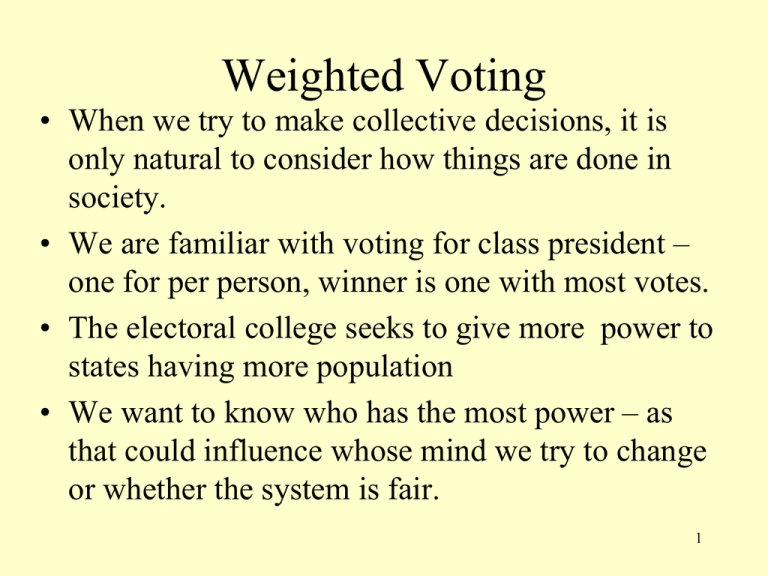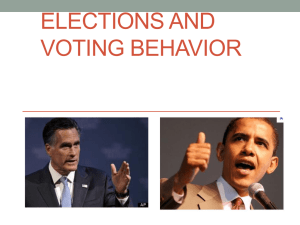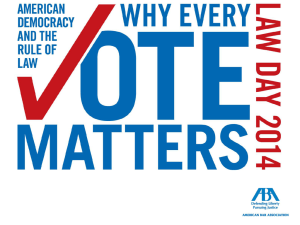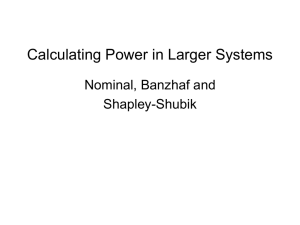Weighted Voting Systems
advertisement

Weighted Voting
• When we try to make collective decisions, it is
only natural to consider how things are done in
society.
• We are familiar with voting for class president –
one for per person, winner is one with most votes.
• The electoral college seeks to give more power to
states having more population
• We want to know who has the most power – as
that could influence whose mind we try to change
or whether the system is fair.
1
Weighted Voting
• We are trying to decide whether or not a
measure passes.
• The coalition is the group of people that can
get the measure passed.
• Not everyone has the same “clout”.
Modeled as some having multiple votes.
2
Notation
• A weighted voting system is characterized
by three things — the players, the weights
and the quota. The voters are the players (P1
, P2, . . ., PN). N denotes the total number of
players. A player's weight (w) is the number
of votes he controls. The quota (q) is the
minimum number of votes required to pass a
motion. [q:w1,w2…wn]. Normally we
1
w w ... w
q
require that
2
as we can say more interesting things that
3
way.
1
2
n
Power
• A player's power is defined as that player's ability to influence
decisions.
• The power of a coalition is not simply determined by its size.
• Consider the voting system [6: 5, 3, 2].
• Notice that a motion can only be passed with the support of
P1. In this situation, P1 has veto power. A player is said to
have veto power if a motion cannot pass without the support
of that player. This does not mean a motion is guaranteed to
pass with the support of that player – as player 1 doesn’t have
enough votes by himself.
• Who has the most power? How is power divided between the
players with 3 and 2?
4
Weighted Voting Systems – Terms
i. Coalition: any subset of a group of voters that bands
together to either support a measure.
ii. Winning/Losing Coalition: a coalition that has
enough votes to pass a measure is a winning
coalition, otherwise it is a losing coalition.
iii. Dummy: a voter in a winning coalition whose vote
isn’t needed to pass the measure.
iv. Voters Weight: the number of votes each voter has.
v. Quota: the number of votes, q, necessary to pass
a measure.
5
Weighted Voting Systems - Terms
vi. Notation for voting system: [q : w1 , w2 ,..., wn ] where q is
the quota, wi are the individual weights of the voters,
and n is the number of voters.
vii. Requirements:
as otherwise definition of
1.
1
q w1 w2 ... wn dictator is problematic
2
2. q w w ... w as no point is having q larger
1
2
n
viii. Changing q affects the way power is distributed.
ix. Blocking Coalition: subset of voters opposing a
motion with enough votes to defeat it. Any coalition
with weight w q . w w1 w2 ... wn
6
Weighted Voting Systems – Terms
x. Dictator: voter whose voting weight meets or exceeds
the quota for passing a measure. All other voters
are dummies.
xi. Veto Power: a voter who has enough votes to block a
measure is said to have veto power. A voter with
weight w q . A dictator automatically has veto
power.
xii. Critical Voter: in any winning coalition, he is the
voter whose votes are essential to win.
7
Power
• Now let us look at the weighted voting system [10: 11, 6,
3]. With 11 votes, P1 is called a dictator. A player is typically
considered a dictator if his weight is equal to or greater than the quota.
The difference between a dictator and a player with veto power is that a
motion is guaranteed to pass if the dictator votes in favor of it.
• The dictator has veto power. The measure passes if and only if he votes
for it. Since the quota must be more than half the total, a dictator
always has veto power.
• A dummy is any player, regardless of his weight, who has
no say in the outcome of the election. A player without any
say in the outcome is a player without power. Dummies
always appear in weighted voting systems that have a
dictator (provided the quota is more than half total) but also
occur in other weighted voting systems
8
Power
• Consider the voting system [8: 5, 3, 2]. Which are
dictators? have veto power? are dummies?
5 and 3 have veto power. 2 is a dummy
• Consider the voting system [8: 9, 3, 2]. Which are
dictators? have veto power? are dummies?
• Consider the voting system [20:10,10,9]. Which are
dictators? have veto power? are dummies?
• Consider the voting system [7:4,2,1]. Which are dictators?
have veto power? are dummies?
9
Banzhaf power index
(sometimes called Penrose-Banzhaf index)
• Designed to quantify the power a voter has
• defined by the probability of changing an
outcome of a vote
• To calculate the power of a voter using the Banzhaf index,
list all the winning coalitions, then count the critical voters.
A critical voter is a voter who, if he changed his vote from
yes to no, would cause the measure to fail. A voter's power
is measured as the fraction of all swing votes that he could
cast
• Warning: in our electoral college of 50 states, there are
51,476,301,254,318 winning coalitions!
10
An example Game Theory and Strategy by Phillip
D. Straffin:
• [6; 4, 3, 2, 1]
• The winning groups, with underlined critical voters,
are as follows:
• AB, AC, ABC, ABD, ACD, BCD, ABCD
• Notice we assume that we only worry about what
ONE player does in each case.
• There are 12 total critical votes, so by the Banzhaf
index, power is divided thus.
• A = 5/12 B = 3/12 C = 3/12 D = 1/12
11
Consider the U.S. Electoral College.
• There are a total of 538 electoral votes. A majority vote is considered
270 votes. The Banzhaf Power Index would be a mathematical
representation of how likely a single state would be able to swing the
vote. For a state such as California, which is allocated 55 electoral
votes, they would be more likely to swing the vote than a state such as
Montana, which only has 3 electoral votes.
• Example: The United States is having a presidential election between a
Republican and a Democrat. For simplicity, suppose that only three
states are participating: California (55 electoral votes), Texas (34
electoral votes), and New York (31 electoral votes).
12
Consider having republicans win. The democrats winning is
similar. Need 61 votes to win.
Calif Texas
(55) (34)
R R
R R
R D
D R
NY
(31)
R
D
R
R
R
D
States that could
votes votes swing the vote
120
0none
89 31California, Texas
86 34California , New York
65 55Texas , New York
Power, each state has 1/3
Consider a different set of states
Need 55 to win
California
(55)
R
R
R
R
Texas
(34)
R
R
D
D
Ohio
(20)
R
D
R
D
States that could
R D swing
109 0California
89 20California
75 34California
55 54California
14
factor twenty
difference
15
Shapley-Shubik Power Index:
i. Shapley-Shubik Power Index:
a. Permutation: total number of ways n things can
n!
be taken r at a time . P n
.
r
(n r )!
Order is important in a permutation.
n
b. Pn
n!
is used to find the number of ways to
order n elements in a set.
2. 1st voter in a permutation whose vote would make
the coalition a winning coalition is called a pivotal
voter.
3. Shapley-Shubik Power Index is fraction of
permutations in which a voter is pivotal.
16
Shapley-Shubik Power Index:
Given a voting system [q : w1 , w2 ,..., wn ] create a ShapleyShubik table: For this example use {A,B,C} with the voting system
[3:2,1,1]
P 3 3! 6 Pivotal voter is underlined.
3
Banzhaf
AB
AC
ABC
4 1 1
, ,
6 6 6
1. Count number of times A,B, and C are pivotal voters. Divide each
value by 6 to get the Shapley-Shubik Power Index:
4 1
2. Voter A is 6 6 4
times more powerful than B or C. Voter A
has 4/6 or 66.67% of the power in this voting system.
17
factor twenty
difference.
Quite similar.
Factor of 4.1-4.3
difference.
18
Try this one
• Suppose decisions are made by majority
rule in a body consisting of A, B, C, D, who
have 3, 2, 1 and 1 votes, respectively. The
majority vote threshold is 4. There are 24
possible orders for these members to vote:
19
A=1/2, B=C=D = 1/6
[4:3,2,1,1]
ABCD
ABDC
ACBD
ACDB
ADBC
ADCB
BACD
BADC
BCAD
BCDA
BDAC
BDCA
CABD
CADB
CBAD
CBDA
CDAB
CDBA
DABC
DACB
DBAC
DBCA
DCAB
DCBA
B has no more power than C or D
20
Shapley-Shubik Power Index:
1. Sometimes permutations are too large to list all of them
so we do it by grouping.
Consider the voting system [5:3,1,1,1,1,1,1]. 7! = 5040
GSSSSSS 3456789
SSSSGSS 1234789
SGSSSSS 1456789
SSSSSGS 1234589
SSGSSSS 1256789
SSSSSSG 1234569
SSSGSSS 1236789
G is pivotal 3/7 of the time. S is pivotal in (4/7)/6=2/21 of the
time. Therefore, the Shapley-Shubik Power Index is
3 2 2 2 2 2 2
, , , , , ,
7 21 21 21 21 21 21
21








